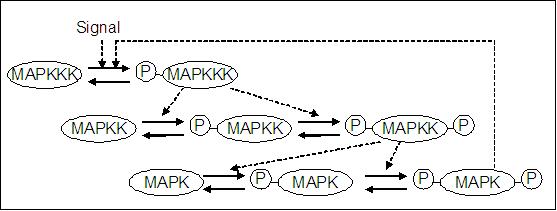Project 1: The MAP kinase pathway
The MAP (Mitogen-Activated Protein) kinases are involved
in a pathway through which information is sent to the nucleus. The MAP kinase
pathway is composed of three consecutive kinases (MAPKKK, MAPKK, and MAPK).
MAPKKK phosphorylates and activates MAPKK, which in turn phosphorylates and
activates MAPK. The cascade is initiated by a signal coming from outside the
cell.

Fig. 1. The MAPK pathway. A stimulus
is sent to a membrane receptor that activates the MAPK pathway.
When MAPKKK is phosphorylated,
it activates MAPKK by phosphorylating it. The same way, MAPKKP
activates MAPK. The message is passed on to the nucleus and translated into
a response.
For example, the stimulus can be progesterone for frog eggs, pheromones for
yeast cells, and growth factors for mammalian cells. Each type of cell exhibits
a different response. In the case of frog eggs, progesterone stimulates immature
oocytes to become mature and ready for fertilization; for yeast cells, pheromones
block the cells in G1 and prepare the cells for mating; and in mammalian cells,
growth factors cause proliferation. Different target proteins turned on by MAPK
kinase pathway define the specificity of the response in different cells.
This cascade seems to behave like a switch in response to external stimuli.
The details on how the cell responds to this external signal are still unclear.
What is already known is that small concentrations of the stimulus do not activate
the cascade, but this activation occurs abruptly after the concentration reaches
a threshold value.
Several mathematical models have already illustrated
this phenomena. Among them, Huang et al. (PNAS, 1996) presented a generic model
of a MAPK pathway as shown below :

Huang et al, 1996 Ultrasensitivity in the mitogen-activated protein kinase
cascade 93: 10078-83 [Abstract]
[PDF]
Project: Build a model in Biocham
of the biochemical reactions presented above (in Huang et al.).
Hints:
1. The first reaction, for example, must be understood in the following way:
MAPK~{p1,p2} acts as a catalyst of MAPKKK phosphorylation. The phosphatase reactions
(reverse reactions : MAPKKK~{p1} => MAPKKK, for example) are caused by KKKPase,
KKPase, and KPase for MAPKKK~{p1}, MAPKK~{p1}, MAPKK~{p1,p2}, MAPK~{p1} and
MAPK~{p1,p2}.
2. Let the signal (Signal) be a molecule
that also binds to MAPKKK and that partially helps the formation of MAPKKK~{p1}.
3. You can use the following parameters.
| Association between MAPKKK and MAPK~{p1,p2} |
a1=5 |
Association between MAPKK~{p1,p2} and KKPase |
a6=3 |
| Dissociation of the complex MAPKKK-MAPK~{p1,p2} |
d1=2 |
Dissociation between MAPKK~{p1,p2} and KKPase |
d6=1 |
| Phosphorylation of MAPKKK |
k1=0.5 |
Dephosphorylation of MAPKK~{p1,p2} |
k6=0.5 |
| Association between MAPKKK~{p1} and KKKPase |
a2=1 |
Association between MAPK and MAPKK~{p1,p2} |
a7=10 |
| Dissociation of the complex MAPKKK~{p1}-KKKPase |
d2=1 |
Dissociation of the complex MAPK-MAPKK~{p1,p2} |
d7=5 |
| Dephosphorylation of MAPKKK~{p1} |
k2=0.2 |
Phosphorylation of MAPK |
k7=2 |
| Association between MAPKK and MAPKKK~{p1} |
a3=5 |
Association between MAPK~{p1} and KPase |
a8=5 |
| Dissociation of the complex MAPKK-MAPKKK~{p1} |
d3=2 |
Dissociation of the complex MAPK~{p1}-KPase |
d8=1 |
| Phosphorylation of MAPKK |
k3=0.5 |
Dephosphorylation of MAPK~{p1} |
k8=0.5 |
| Association between MAPKK~{p1} and KKPase |
a4=3 |
Association between MAPK~{p1} and MAPKK~{p1,p2} |
a9=10 |
| Dissociation of the complex MAPKK~{p1}-KKPase |
d4=1 |
Dissociation of the complex MAPK~{p1}-MAPKK~{p1,p2} |
d9=5 |
| Dephosphorylation of MAPKK~{p1} |
k4=0.5 |
Phosphorylation of MAPK~{p1} |
k9=2 |
| Association between MAPKK~{p1} and MAPKKK~{p1} |
a5=5 |
Association between MAPK~{p1,p2} and KPase |
a10=5 |
| Dissociation of the complex MAPKK~{p1}-MAPKKK~{p1} |
d5=2 |
Dissociation of the complex MAPK~{p1,p2}-KPase |
d10=1 |
| Phosphorylation of MAPKK~{p1} |
k5=0.5 |
Dephosphorylation of MAPK~{p1,p2} |
k10=0.5 |
| Association between MAPKKK and the signal |
ks=0.1 |
|
|
| Dissociation of the complex MAPKKK-Signal |
ks1=0.5 |
|
|
| Phosphorylation of MAPKKK~{p1} |
ks2=0.05 |
|
|
Initial conditions
| Signal |
1 |
MAPKKK-Signal |
0 |
| MAPKKK |
1 |
MAPKKK-K~{p1,p2} |
0 |
| MAPKKK~{p1} |
0 |
MAPKKK~{p1}-KKKPase |
0 |
| MAPKK |
1 |
MAPKK-MAPKKK~{p1} |
0 |
| MAPKK~{p1} |
0 |
MAPKK-{p1}-KKPase |
0 |
| MAPKK~{p1,p2} |
0 |
MAPKK~{p1}-MAPKKK~{p1} |
0 |
| MAPK |
1 |
MAPKK~{p1,p2}-KKPase |
0 |
| MAPK~{p1} |
0 |
MAPK-MAPKK~{p1,p2} |
0 |
| MAPK~{p1,p2} |
0 |
MAPK~{p1}-KPase |
0 |
| KKKPase |
0.1 |
MAPK~{p1}-MAPKK~{p1,p2} |
0 |
| KKPase |
0.1 |
MAPK~{p1,p2}-KPase |
0 |
| KPase |
0.1 |
|
|
Questions:
You should see the
consecutive activation of the three kinases.
You can now test the model.
1. Try several values of "Signal" (in [0,1])
and explain what you observe. Delete the positive feedback coming from MAPK~{p1,p2}
on MAPKKK phosphorylation. What is the role of the positive feedback in this
model?
2. Instead of describing the system using complexation
and release of the phosphorylated form, use Michaelis menten kinetics to model
the pathway.
3. Delete all the parameters,
and submit queries on the model using NuSMV. Describe in details the queries
and what you expect to see.
Comments: The variable "Signal" is a pulse
that starts the cascade. The activation is maintained by the positive feedback
coming from MAPK~{p1,p2}. The model doesn't account for the filtering of the
stimuli. Any value of S will activate more or less rapidely the cascade.
It is believed that a negative feedback (MAPK~{p1,p2} activates its own phosphatase
for example) associated with the positive feedback might account for the "all-or-none"
response of the cascade that cannot be seen here (e.g. small stimuli won't activate
the cascade but when the intensity of the stimuli reaches a threshold, the system
is activated).